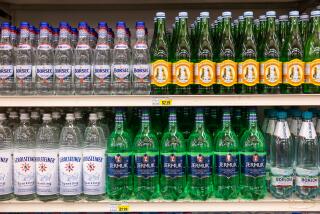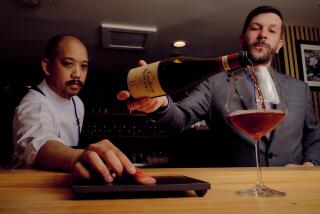Now Is the Time for a Better Kosher Wine
Yitzchak Applbaum is a wine lover. He has sniffed many great wines, from BV Private Reserve to Chateau Latour. He has tasted none of them.
That’s because Applbaum is an orthodox Jew for whom only kosher wine is permissible. Latour and most of the other great wines of the world are not kosher.
“I am the son of a rabbi and the grandson of a rabbi and this is the way I live,” says Applbaum, who boasts one of the world’s widest collections of kosher wine. He admits that his love of wine and his orthodox lifestyle aren’t as compatible as he’d like them to be, but he has his favorite wine--his own.
“It was so difficult to get a good kosher red wine,” he says, “that we decided to do our own.” Applbaum’s partners in the venture were his wife, Hilda; Dr. Arthur Huntley, and Huntley’s wife, Rivkah Isseroff. The result of their efforts is the 1990 Teal Lake Cellars Pinot Noir; the first release is just appearing on store shelves.
Making kosher wine is a complicated process. Although it uses the same grapes as ordinary wine, and the fermentation is virtually identical, kosher law requires two things: The hoses and tanks must be cleaned more rigorously than in standard wine making, and the wine must be made by orthodox Jews. And finding those people isn’t easy.
Kosher wineries often have workers--called shadows--who are hired only to handle tasks the rules say must be done by observant Jews. “I call it hands-in-the-pocket wine making,” says Robert Weinstock, owner of Weinstock Cellars, a kosher winery in Sonoma County.
“I’m Jewish,” explains assistant wine-maker Victor Schoenfeld of Yarden, a wine producer in Israel, “but I’m not orthodox, so when I’m in the winery, I can’t turn on a spigot and draw a sample from a tank. The spigot has to be opened by a Sabbath observant Jew.”
There are other rules as well. Kosher wine is made in two levels: standard kosher wines and mevushal wines. A standard kosher wine may be consumed by any observant Jewish person, but it immediately loses its kosher certification if it is opened and served by a non-observant Jew. A mevushal wine, which has been heated to a specified temperature, remains kosher no matter who serves it.
The fact that most kosher wines were mevushal is one reason kosher wines have had such a bad name. The old methods of heating wine usually robbed it of its character; for decades, the only dry kosher wine in the United States was imported from Israel and made by Carmel. Founded in 1882 by Baron Edmund de Rothschild, of the French Rothschilds, Carmel is the world’s largest kosher wine producer; all of the 4 million cases it produces annually is mevushal wine.
To combat this problem, Hagafen Cellars was founded in 1979 to make dry kosher wine in the Napa Valley without heating. At the same time, an Israeli company, Yarden, began attempting to make a quality kosher wine. The two companies were soon joined by Weinstock Cellars and Gan Eden, both in Sonoma.
But in the last few years, technology has developed new ways to make mevushal wine while preserving its quality. The temperature of the juice is raised very rapidly before fermentation. Then the juice is chilled again; this makes for a much better aroma than that of the kosher wines of the past.
Founder Ernie Weir of Hagafen (the Hebrew word for vine) said that as more modern methods of heating became available, all of his white wines became mevushal . So did the wines of Weinstock Cellars. “The secret is how long you heat the wine,” says Weinstock, who developed a heating chamber that raises the temperature of the juice to 170 degrees before fermentation, then chills it again instantly. “It’s like a steak. If you allow it to stay hot, it continues to cook.”
The other reason why kosher wines have had a bad name is that so many of them have been made sweet and heavy. But consultant Peter Stern of San Jose, who has probably made more kosher wines than anyone (he’s a consultant to kosher wine producers all over the world), says the concept of sweet kosher wine is relatively new.
Royal Wine Corp., which was founded some 200 years ago in Czechoslovakia, once made only dry kosher wines. But, says Stern, “when the company moved here, they were founded in New York and the local New York grape was Concord, and it made sweet wine better than dry, so . . . .”
Once a kosher wine is made, it must be certified. Teal Lake and Hagafen use individual rabbis--Hagafen’s certification is done by Rabbi Dr. J. H. Ralbag of New York; Teal Lake uses Rabbi Stuart Rosen of Sacramento. Weinstock and Gan Eden use the Union of Orthodox Congregations of America (shown by a U in a circle).
Another certification that may be seen on a wine label is “kosher for Passover.” A wine that is so specified is guaranteed to have been made without any grain or grain products (though these are in fact rarely used in wine production).
More kosher wine is sold for Passover than at any other time of the year. This is because wine is an elemental part of the celebration of the Seder, the traditional Passover meal that brings Jewish people together for a ritual feast. Four times during the Seder dinner there are blessings for a glass of wine, and each time it is traditional to consume most of the contents of the glass. And even some Jews who do not observe the kosher laws in every detail tend to believe the Seder wine should be kosher.
More to Read
Eat your way across L.A.
Get our weekly Tasting Notes newsletter for reviews, news and more.
You may occasionally receive promotional content from the Los Angeles Times.










